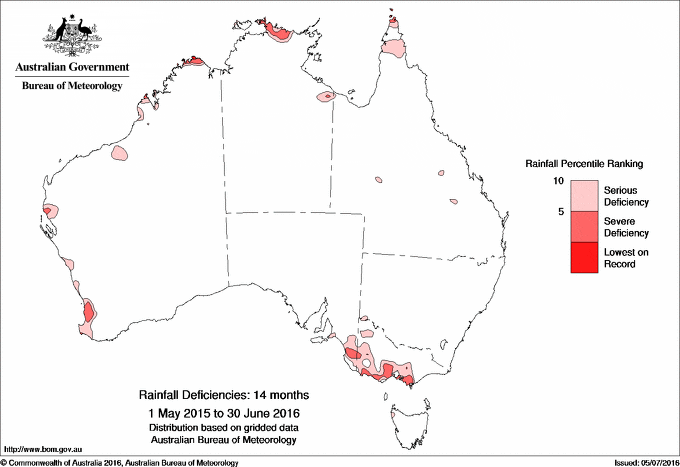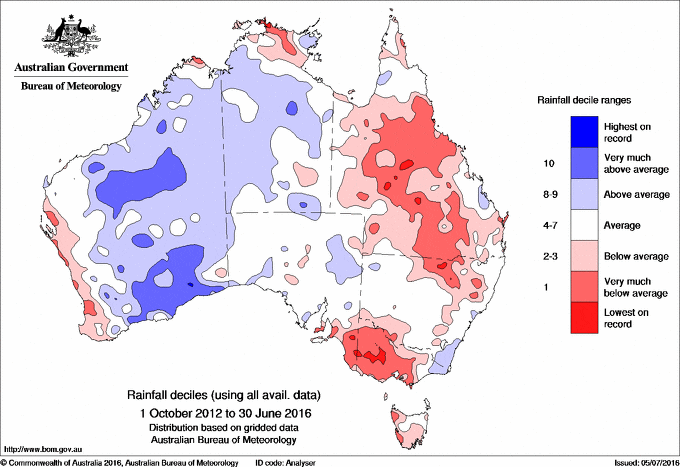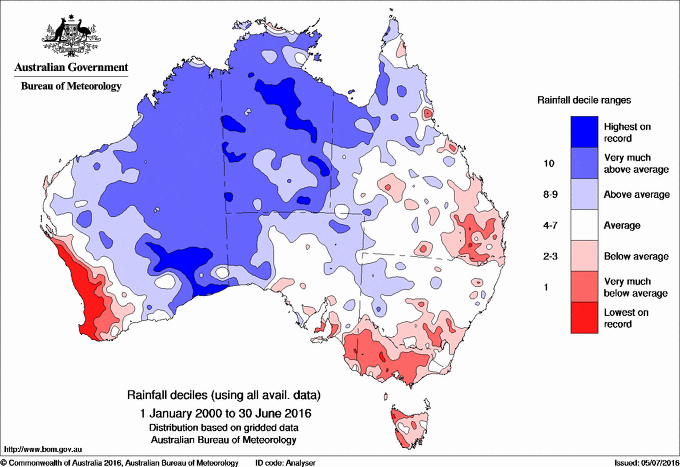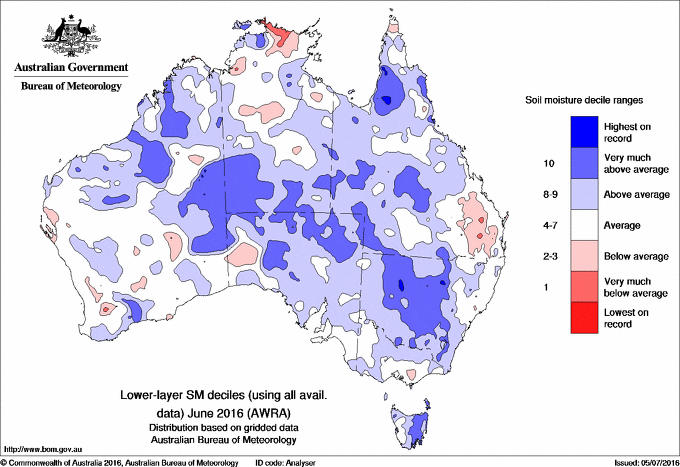June 2016 was Australia’s second-wettest June on record, according to the Bureau of Meteorology.
Significantly, central Queensland had its highest on record rainfall for the period.
Most of the rainfall deficiencies listed on the Bureau’s 14 month rainfall deficiency map have been removed following widespread June rainfall (see below).
Areas of serious to locally severe rainfall deficiency remain in parts of South Australia and Victoria.
Areas that received below-average rainfall in June included the lower southwest of Western Australia and a band from the northwest Kimberley to the tip of the Cape York Peninsula.
Despite the impact of June rain, however, many areas remain in serious long-term rainfall deficits, and still require above-average rainfall over a sustained period.
Since the most recent La Niña concluded in autumn 2012, rainfall has generally been below average over large parts of Queensland and into northern New South Wales, and also over western Victoria, Tasmania and southwest Western Australia.
The 2015–16 wet season provided rain to some, though not all, parts of the affected areas of Queensland, and was followed by a wet June. There was also significant rain during late autumn and early winter in Victoria and Tasmania.
However, the accumulated rainfall deficits over the past four years in these areas are very large, and will require a great deal more rain to remove them. Rainfall analyses for standard periods out to 36 months are available on the Bureau’s website.
Very long-term deficits in southern and eastern Australia
Rainfall in much of southern and eastern Australia has been generally below the long-term average since at least the beginning of this century.
The period from January 2000 has been the driest period on record in large parts of southwest Western Australia, and very much below average over much of southeast South Australia, Victoria, Tasmania, southern New South Wales and southeast Queensland.
It has also been the warmest such period on record in these areas. Conversely, rainfall in northwestern Australia has been very much above average during the same period.
Southern Australia typically gets significant rainfall from autumn through spring from cold fronts and low pressure systems.
However, this activity has substantially decreased in Australia over recent decades, as high pressure systems have become more dominant.
The Bureau’s says this suggests the tendency for recurrent dry conditions is less related to natural climate drivers such as El Niño, and increasingly due to changes in the climate.
“Research suggests that long-term drying trends over southern Australia cannot be explained by natural variability alone.”
Comprehensive reports on changes in Australia’s climate are available at the Bureau’s Climate Change in Australia website.
Soil moisture
Well above average rainfall in June affected much of the country and has increased the relative amount of available soil moisture in the lower layer (from 10 to 100 cm deep) in several areas.
Soil moisture is now above average in much of eastern Australia. The main exception is the southeastern interior of Queensland where soil moisture remains below average with isolated pockets that are well below average.
June’s rainfall in Tasmania has resulted in well above average soil moisture for most of the State. Very much above average soil moisture is also evident in Australia’s central interior near the borders of Western Australia, the Northern Territory and South Australia; in the Pilbara and Kimberley; in Queensland’s Central West and southern parts of Cape York Peninsula; and in much of New South Wales. There are isolated pockets of record-high June soil moisture in some areas. Soil moisture was above average along the Esperance and Eucla Coasts of Western Australia.
Below-average soil moisture is apparent in parts of Western Australia’s Central Wheat Belt and near the Gascoyne Coast. Soil moisture was below average near the tip of the Cape York Peninsula and in the Northern Territory’s interior, whilst below to very much below average soil moisture is evident in parts of the Top End.
Soil moisture information presented here is from the Bureau’s operational Australian Water Resources Assessment Landscape (AWRA-L) model.




